Ball of fire
“I felt an intense flash of heat and turned around and saw a ball of fire coming towards me. I didn’t know what it was. I just followed it, snapping away without stopping. Then I heard the screams and realized what had happened. Ten seconds and it was over.”
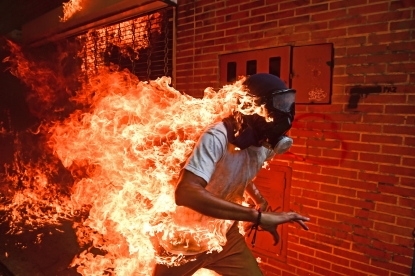 (AFP / Ronaldo Schemidt)
(AFP / Ronaldo Schemidt)That’s how Ronaldo Schemidt snapped the photo that netted him the prestigious World Press Photo of the Year award for 2018.
A Venezuela native, Ronaldo is based in Mexico City, but returned to his homeland to cover the protests convulsing it last year, with thousands of people pouring out into the streets for weeks, demanding the departure of President Nicolas Maduro.
Along with the rest of the team, he spent weeks in a haze of non-stop work, covering the often deadly clashes between the protesters and security forces.
Being in the right place at the right time is everything to catch such a picture.
On May 3, Ronaldo and his colleague Juan Barreto were out on the streets, as usual, covering demonstrations when they happened upon a group trying to destroy a police motorbike. The bike's gas tank suddenly exploded.
"I felt the explosion behind me and I felt the heat and at that moment I turned around, already shooting, but without seeing what was going on," Ronaldo said.
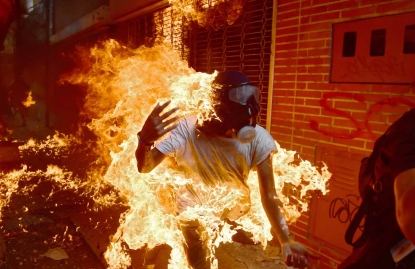 (AFP / Ronaldo Schemidt)
(AFP / Ronaldo Schemidt)The flames engulfed 28-year-old Victor Salazar, who survived the incident with first- and second-degree burns.
"I didn’t think in that moment that I would win any prize with it, but I was really shocked at what I was seeing because I had never seen something that violent," Ronaldo says.
For the World Press jury, Ronaldo's searing image symbolized the country "burning."
Ronaldo, 46, left his home country 18 years ago, but still has family and friends there, so the prize for the image is a bittersweet one for him. His own family has been caught up in the hunger, hyperinflation and shortages that sparked the four months of protests and street battles that left 125 people dead.
"I have conflicting emotions," he says. "I know as well as anyone what Venezuela is going through."
"For me, the picture represents the state of the country," Ronaldo says. "It's a humanitarian crisis."
"It's a portrait of what Venezuela was then," he says. "But now it's even worse."
Covering the clashes, Ronaldo, Juan and their colleagues had to be right in the thick of things. Which means they often got caught up in the clashes themselves. As Juan put it: “I’ve been struck by both stones and tear gas.”
 (AFP / Juan Barreto)
(AFP / Juan Barreto)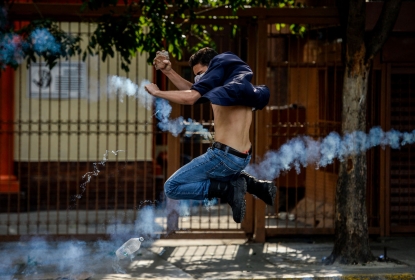 Caracas, 26 avril 2017. (AFP / Federico Parra)
Caracas, 26 avril 2017. (AFP / Federico Parra)
Tear gas was a daily presence in coverage and Ronaldo found out that he had an allergy to the chemicals. As if the work wasn’t hard enough.
The clashes got ever more vicious as time went on. “We have gas for the entire afternoon!” “Aim for the knees!” security forces would taunt protesters over loudspeakers. Meanwhile the hooded youths facing them would increase their volleys of stones and insults, being less and less afraid with each passing day.
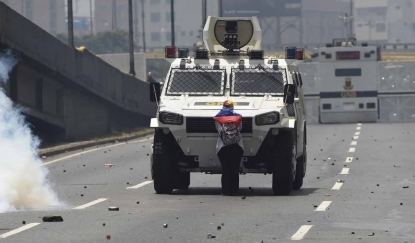 Caracas, April 19, 2017.
(AFP / Juan Barreto)
Caracas, April 19, 2017.
(AFP / Juan Barreto)As if the situation weren’t dangerous enough, it was made more so by the armed gangs that roamed the streets on motorcycles day and night. And then there were the thieves, always on the lookout for the photographers’ expensive equipment.
Ronaldo wasn’t the only one to get capture the protester on fire.
His colleague Juan shot a series of photos of the same scene that netted him 3rd place in Spot News Stories category. His photos told the story of how the protester caught on fire -- he along with several others were trying to damage the police motorcycle when its gas tank exploded.
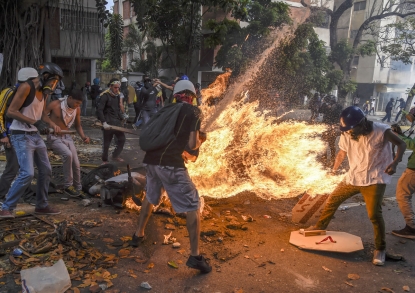 Caracas, May 3, 2017.
(AFP / Juan Barreto)
Caracas, May 3, 2017.
(AFP / Juan Barreto)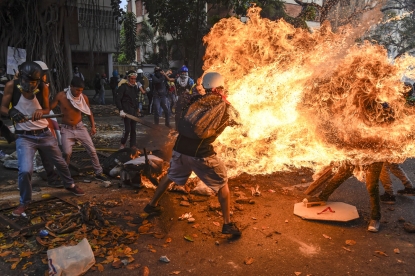 Caracas, May 3, 2017.
(AFP / Juan Barreto)
Caracas, May 3, 2017.
(AFP / Juan Barreto)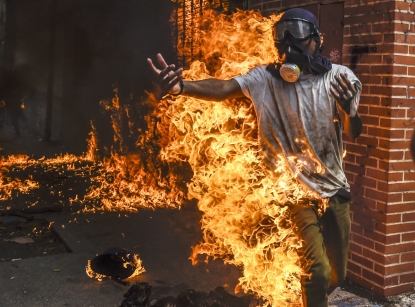 Caracas, May 3, 2017.
(AFP / Juan Barreto)
Caracas, May 3, 2017.
(AFP / Juan Barreto) Caracas, May 3, 2017.
(AFP / Juan Barreto)
Caracas, May 3, 2017.
(AFP / Juan Barreto)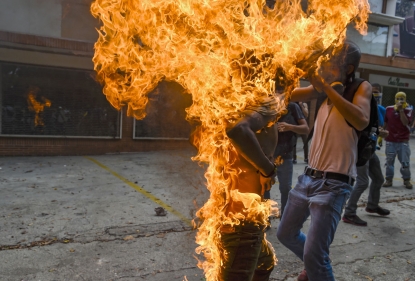 Caracas, May 3, 2017.
(AFP / Juan Barreto)
Caracas, May 3, 2017.
(AFP / Juan Barreto) Caracas, May 3, 2017.
(AFP / Juan Barreto)
Caracas, May 3, 2017.
(AFP / Juan Barreto) Caracas, May 3, 2017.
(AFP / Juan Barreto)
Caracas, May 3, 2017.
(AFP / Juan Barreto)Ronaldo and Juan faced tough competition -- 42 photographers from 22 countries were nominated in eight categories. In total, some 3,548 photographers from 125 countries submitted 73,044 images to the jury for consideration this year.





